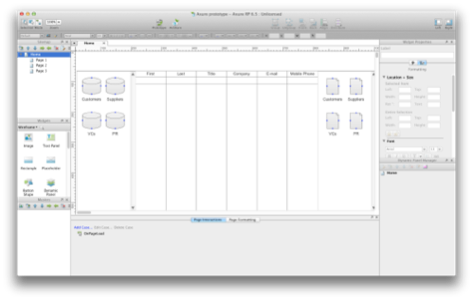
You have a brilliant software idea. Now you need to design a good-looking prototype. You look around. You search high and low. Chances are you will dig up a sum total of three usable tools.
That’s right, three.
Rapid Prototyping Is A Wasteland
Welcome to the largely ignored world of rapid prototyping.
If you design on the PC, you can choose from three tools:
- Axure RP ($290)
- Mockup Builder (free)
- Serena Prototype Composer 3 (free/$300)
If you prototype on the Mac, your three choices are:
- Axure RP
- Balsamic Mockups ($79)
- Sencha Architect ($400)

If you develop mobile apps or websites, there are more choices, including Protoshare ($29/mo.), a Web-based (SaaS) software solution and Tiggzi ($40/mo.). If you like to design apps entirely on the iPad, there’s AppCooker ($40), AppSketcher (free), Blueprint Lite (free), Interface HD ($10), iMockups for iPad ($7) and Mockop (free), plus many others.
According to an educated guess, there are some 12 million programmers worldwide. That’s equal to the population of metropolitan Los Angeles.
Now imagine you are one of those 12 million LA inhabitants, and you have only three, maybe four, auto repair shops to choose from. What’s wrong with that picture? The size of the global information technology industry was estimated at $3.8 trillion in 2012, according to Gartner.

Here’s a another cogent example. I searched the Home Depot site for cordless drills and found 348 search results. Try it yourself. And that’s for a global power tool market that will reach only $27 billion by 2015.
The Disconnect Opportunity
Notice a disconnect here? In a previous post, I wrote about the need to create 1,000 user-experience (UX) design studios in the U.S. alone. These studios would require a healthy infrastructure of innovative rapid prototyping and coding tools. Yet it’s clear that when it comes to creating software, designers lack much choice.
What type of prototyping tools are needed? For one, they should be collaborative. I know this because I found a sparse factoid on the design activities of programmers that suggests that unlike the relatively solitary activity of coding and testing, designing interfaces requires much collaborative work.
Finding the above statistic buried in a Microsoft site full of articles about finding bugs was a worrisome sign all in itself. You would think that, given a $4 trillion information technology economy, there would be a lot more research about software-design habits.
Please plug this innovation gap, entrepreneurs and venture capitalists! We need a lot more help to make software work the way it was intended. And do contribute to my crowdsourced ideation engine and suggest more ideas on what type of software is needed to help create a next-generation software economy.
Lead image courtesy of Shutterstock.

















